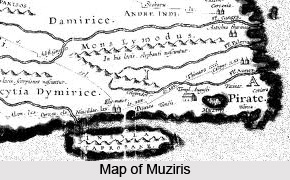 St. Thomas is believed to have landed at the port of Muziris in Kerala in A.D. 52, and started his work of conversion. All the Christians of India believe that, from this date, their Church began and has carried on without interruption. This tradition is backed up only by other traditions; there is no contemporary evidence which bears upon the arrival of the first Christian teacher. However, the traditions are several and insistent enough to induce in anyone who examines them a strong subjective tendency towards acceptance.
St. Thomas is believed to have landed at the port of Muziris in Kerala in A.D. 52, and started his work of conversion. All the Christians of India believe that, from this date, their Church began and has carried on without interruption. This tradition is backed up only by other traditions; there is no contemporary evidence which bears upon the arrival of the first Christian teacher. However, the traditions are several and insistent enough to induce in anyone who examines them a strong subjective tendency towards acceptance.
St. Thomas, as per the legend, advocated the gospel at Muziris with great patience, waiting for a period of eight months before he formed his first congregation. Then, while living in the Jewish quarter of the city, he is believed to have converted the local raja, and four hundred Hindus and forty Jews. Then, he founded seven churches, at Parur, Quilon, Cranganore, Palur and other places on the Keralan coast where the Christian community is undoubtedly very ancient. Finally he departed, for Chennai (Madras), and preached on the Coromandel Coast, until he was murdered by hostile Hindus and buried on the place of the present cathedral of Mylapore.
There are some non-Christian traditions which bear at least obliquely on this account. The Syrian Christians, who were the members of the church St. Thomas is believed to have founded, consider them superior to other Christians, and establish their claim to high social standing on the legend that many of the converts by St. Thomas were of high caste - either Namboodiri Brahmins or Nayars; this claim is unexpectedly supported by an anti-Christian tradition of the Brahmins themselves, recorded in the Keralol-patti, and as per it, a certain Thoman, who was opposed to ail Vedas, visited Malabar and converted several prominent people in the land, which includes the reigning king, Bana Peramal. The tradition of Jews in Cochin (presently Kozhikode) also support the Christian legend, first by repeating the account of the arrival of St. Thomas and secondly by claiming the existence of a Jewish colony at Muziris though the date they usually give for their own arrival is A.D. 69, which is about seventeen years after the traditional date of landing of St. Thomas.
 According to the story of St. Thomas itself, it is so early and so strongly held by the Indian Christians that the same cannot be lightly dismissed, and certain aspects possess at least good circumstantial evidence. The pre-Malabar part of the legend of St. Thomas gives an account of how the saint went to Taxila in the north-western India to work as a master carpenter for Gondophares, the Parthian king, whom he converted. The changeover of kings is a convention of hagiographers, and can normally be ignored; the small details of a legend are often more significant, and the key detail here is the name of the king. All records of Gondophares apart from the St. Thomas legend were lost until the later half of the 19th century, and he was dismissed as a figure of legend.
According to the story of St. Thomas itself, it is so early and so strongly held by the Indian Christians that the same cannot be lightly dismissed, and certain aspects possess at least good circumstantial evidence. The pre-Malabar part of the legend of St. Thomas gives an account of how the saint went to Taxila in the north-western India to work as a master carpenter for Gondophares, the Parthian king, whom he converted. The changeover of kings is a convention of hagiographers, and can normally be ignored; the small details of a legend are often more significant, and the key detail here is the name of the king. All records of Gondophares apart from the St. Thomas legend were lost until the later half of the 19th century, and he was dismissed as a figure of legend.
Then, in Taxila, coins assuming his name were discovered, and it was proved that he must have reigned in that city about A.D. 50, the probable date of the visit of the saint. The Parthians of Taxila, devoted Philhellenes, imported from the Levant several craftsmen who formed in Taxila a debased form of Greek architecture and art and St. Thomas may well have been one of them. Lastly, in the state of Kerala during the first century, there was a great demand for master carpenters to construct the royal palaces financed by the profits of the pepper trade; the craft of Thomas would have made him equally welcome there.
The belief in the apostolate of St. Thomas to India was already founded in the Levant by the forth century A.D., when both Jerome and Chrysostom referred to it, and was kept so much alive during the Middle Ages that when the new wave of European visitors began to reach South India in the 1290s - Marco Polo on his way home and the Franciscan friar John of Monte Corvino going in the opposite direction on his way to China - they made a point of paying a visit to the supposed site of the martyrdom of the St. Thomas in Chennai (Madras).






































